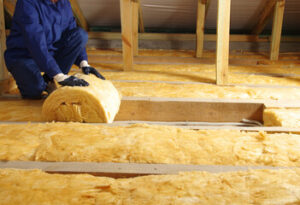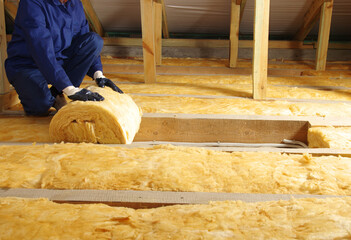Insulation Contractors Houston can be a great way to save money on energy bills. It helps keep heat inside during the winter and cool air out during the summer.
The effectiveness of home insulation is measured by its R-value, with higher numbers indicating greater thermal resistance. For the best results, use the recommended R-value for your climate.

Home insulation is a significant investment, but one that can save you money in energy costs. The average home can expect to cut its energy bills by about 20 percent with proper insulation. This can pay for itself in just a few years, making it a good investment for any homeowner.
When calculating the cost of home insulation, consider the type of insulation you choose as well as labor costs and any other associated expenses. The amount of energy your home uses will also affect the cost of insulation. In addition, you should take into account the type of home you have and the R-value that you want to achieve.
There are several different types of home insulation available, with each offering its own set of benefits. Some common types include foam boards, spray foam, and loose fill. These materials can be used in various spaces and are available at varying prices.
Foam insulation comes in two forms: open and closed cells. Open-cell foam is flexible and pliable, while closed-cell is stiff and can pull on studs. Typically, open cell is used in new construction homes, while closed cell foam is used mainly for existing homes.
A large portion of the cost of home insulation is labor. Hiring a professional installer can help you avoid mistakes and save money on the installation process. Additionally, the right insulation can make your home more comfortable and reduce utility costs.
Another factor in determining the cost of home insulation is the local area. Some areas have specific energy requirements and require a certain R-value to qualify for rebates. In these cases, it may be necessary to install additional energy upgrades at the same time as installing insulation.
Home insulation is a great way to lower your energy costs and increase the value of your home. It can also protect your health by reducing dust and other allergens. In addition, it can keep pests like termites away. It is important to remember that not all insulation products are created equal, so make sure you choose the best option for your home.
Home insulation helps to reduce the amount of energy your house consumes to stay warm or cool. In addition, it can reduce noise pollution by absorbing and enclosing reverberating sound. This can be especially helpful if you live in a busy area or have snore neighbors.
A home that needs to be properly insulated wastes up to 15% of the energy it uses. This energy loss is due to air leaks, which can occur around windows, doors, and attic vents. Insulation is the best way to stop this energy loss and keep your home comfortable all year round.
If you are considering selling your home in the future, home insulation is a great investment because it will increase its value. Potential buyers are more interested in homes that are energy efficient and will pay a premium for a house that is already well insulated. Home insulation is also a great way to reduce heating and cooling costs, saving you up to $2,500 annually.
Besides saving money, home insulation also helps to protect your family from health issues. Insulation keeps indoor temperatures consistent, which prevents mold and other respiratory illnesses. It also blocks external pollutants, such as dust and pollen, that can cause allergies and asthma attacks. Additionally, it protects against high outdoor temperatures, which can lead to heat rash, cramps, and exhaustion.
Another benefit of home insulation is that it reduces greenhouse gas emissions. This is because fewer resources are used to produce energy, which helps the environment. Additionally, some types of home insulation are made from biodegradable materials, which makes them environmentally friendly.
Finally, home insulation can also help to prevent pest infestations. It acts as a barrier to invasive insects like wood-eating ants and termites that can damage the structural integrity of your home. It is important to choose the right type of insulation to ensure that it provides these benefits and to make sure it is installed correctly. Lastly, some types of insulation are fire resistant, providing additional protection for your home.
Home insulation is available in various materials and can be installed in multiple ways. Foam, fiberglass, cellulose, and sheep’s wool are the most common choices for residential homes. These options are available in pre-cut blanket form or a roll form and can be cut to fit the standard width between wood-frame wall studs or attic rafters. They can also be blown into place or poured into place. Foam insulation, usually made from polystyrene, polyisocyanurate, or cementitious foam, is injected into walls to create high thermal resistance and can be used in any house area.
The type of facing and barrier, if any, that you choose will depend on the climate in which you live and the method by which the insulation is being installed. Common facings include kraft paper, white vinyl sheeting, and aluminum foil. The choice of facing material, if any, will affect whether the insulation acts as an air or vapor barrier. If the insulation is installed in the attic, it should be covered with a vapor and radiant barrier to reduce moisture condensation and prevent mold growth.
Fiberglass is the most popular insulation material. It’s affordable, easy to install, and provides R-values between R-3 and R-6 per inch of thickness. It may be blown into or placed between existing walls, although it requires a skilled installer for best results. It’s also possible to do a DIY project with fiberglass, although you should take precautions when cutting around pipes and wires.
Rockwool is denser than fiberglass and offers higher R-values, but it can be more expensive. It’s often installed with drywall and can be a good option for new construction or re-insulating an existing wall. It’s sometimes mixed with vermiculite and boracic acid as fire retardants to make it safer.
Cellulose is made from recycled newspapers, cotton, wool, and other materials and can be blown into ceilings or placed in open walls. It can also be poured or pumped into attics to fill hard-to-reach areas and meet specific R-value requirements. It’s a good choice for cold climates. It can settle and lose effectiveness over time, and it’s more prone to fire than other types of insulation.
Home insulation improves the efficiency of a home and helps to lower energy bills. Whether you are building a new home or renovating your existing one, installing insulation will help keep warm air in during the winter and cold air out in the summer. It can also help buffer sound and make a home more comfortable year-round. Depending on the type of insulation chosen, it can be installed as a DIY project or by hiring a professional. However, there are several things that you should consider before beginning the installation process.
First, it is important to ensure that the area being worked on has sufficient ventilation. This will prevent dust and other debris from settling into your living space. It is also a good idea to use a mask and eye protection while working. If you are unsure how to handle any tools or equipment properly or are uncertain of the level of work involved, consider hiring a professional insulator.
Before you can begin the installation process, it is essential to clear out the area where the insulation will be installed. This will make it easier to access the walls and help you avoid damaging your belongings or causing harm to yourself. It would be best to cover any areas not insulated using plastic sheeting. Finally, it is a good idea to cover any electrical wires in the area with tape or another protective covering.
The first step in the insulation installation process is to remove any nails or screws from the wall studs and tack strips, which should then be pounded down or removed entirely. The area should then be vacuumed to clear out any debris, and the walls should be wiped down with a damp cloth. Next, you should measure the height of the walls and purchase insulation batting that is appropriate for the size of your home. If the batting is not pre-cut, it should be cut to the proper length before being stapled. Ensure that you are using a staple gun that can be used on fiberglass, and make sure the stapling points are not directly against any wires or other heat sources, which could pose a fire hazard.
